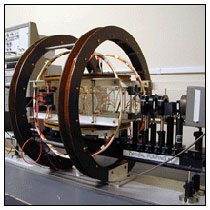|


Measurement of the Zeeman splittings
of the ground state of the natural rubidium isotopes;
measurement of the relaxation time of the magnetization
of rubidium vapor; and measurement of the local
geomagnetic field by the rubidium magnetometer.
Rubidium vapor in a weak (~.01-10 gauss) magnetic
field controlled with Helmholtz coils is pumped
with circularly polarized D1 light from a rubidium
rf discharge lamp. The degree of magnetization
of the vapor is inferred from a differential measurement
of its opacity to the pumping radiation.
In the first part of the experiment
the energy separation between the magnetic substates
of the ground-state hyperfine levels is determined
as a function of the magnetic field from measurements
of the frequencies of rf photons that cause depolarization
and consequent greater opacity of the vapor. The
magnetic moments of the ground states of the 85Rb
and 87Rb isotopes
are derived from the data and compared with the
vector model for addition of electronic and nuclear
angular momenta.
In the second part of the experiment
the direction of magnetization is alternated between
nearly parallel and nearly antiparallel to the
optic axis, and the effects of the speed of reversal
on the amplitude of the opacity signal are observed
and compared with a computer model. The time constant
of the pumping action is measured as a function
of the intensity of the pumping light, and the
results are compared with a theory of competing
rate processes - pumping versus collisional depolarization.
Student Wiki: Optical Pumping of Rb Vapor
Download
Lab Guide in PDF format
(certificates
required)

- W. E. Bell and A. L. Bloom,"Optical
Detection of Magnetic Resonance in Alkali Metal Vapor", Phys.
Rev., 107, pp 1559, (1957)
- A. Bloom, "Optical
Pumping", Sci. Am., Oct, (1960)
- R. L. De Zafra, "Optical
Pumping", Am. J. Phys., 28, (1960)
- R. Bernheim, Optical
pumping; an introduction, (New York, W. A. Benjamin, 1965).
- Pages 6-8 of this long (270 page) pdf file contain a table of contents.
- R. Benumof, "Optical
Pumping Theory and Experiment", American Journal of Physics,
33, pp.151-160, (1965)
- M. Nagel and F. E. Haworth, "Advanced
Laboratory Experiments on Optical Pumping of Rubidium Atoms-Part I: Magnetic
Resonance", American Journal of Physics, 34, pp.553-558,
(1966)
- S. G. Kukolich, "Time
Depencend of Quantum-State Amplitudes Demonstrated by Free Precession
of Spins",
Am. J. Phys., 36, (1968)
- F. K. Richtmyer, E. H. Kennard, and J. N. Cooper, Introduction
to Modern Physics 6th ed., (New York, McGraw-Hill, 1969), "Atomic
Structure and Optical Spectra", pp. 269-305
- H. Semat and J. Albright, Introduction to Atomic and Nuclear Physics,
(New York, Holt, Rinehart and Winston, 1972), "Optical
Spectra and Electronic Structure",
Chap. 9, pp. 256-300
- R. D. Evans, The Atomic Nucleus, (Malabar, FL, R.E. Krieger,
1982, c1955), "Atomic
and Molecular Effects of Nuclear Moment Parity, and Statistics",
Chap. 5, pp.181-187

- Geomagnetism: The Magnetic Field of the Earth
- Optical Pumping Schematic
- Linear Polarizer
- Near and Far photodiode detectors
- 794.7nm narrow-band optical filter
- 3" 17.2cm focal length (near) field lens
- 3" 23.3cm focal length (far) field lens
- 1/4 wave retarder
- MIT variable attenuator
- Omega temperature indicator MDSS116-TC-A
- Tektronix CMC250 Frequency Counter
- MIT Rb lamp
- MIT Rb lamp power supply
- MIT 3-axis helmholtz coils
- MIT helmholtz coil current supply
- EG&G HUV 4000B Silicon Photodiode
- Circuit Diagram for Lamp Power Supply Panel
- Sanyo DL3038-011 Laser Diode (635nm)
- Spectra
Physics Current Pre-amplifier (Mo.# 70710)
- ThorLabs LDC 500 Laser Diode Controler
- Documentation on the Power
Supplies for MIT Rubidium discharge lamps (By Jim Gray)
- Condor Linear DC Power Supplies - 5V @ 1.5A
- Asahi Model AP-101 Digital Panel Meter
- Omega DP24-T Thermocouple Meter
- W. E. Bell, A.L. Bloom and J. Lynch, "Alkali Metal Vapor Spectral Lamps", Review of Scientific Instruments, 32, pp. 688-692, (1961).
- R. G. Brewer, "High Intensity Low Noise Rubidium Light Source", Rev. Sci. Instr., 32, pp. 1356-1358, (1961).
- D. Shernoff, "Mercury Lamp for Optical Pumping", Rev. Sci. Instr. Vol. 40, pp.
1418-1419, 1969
|